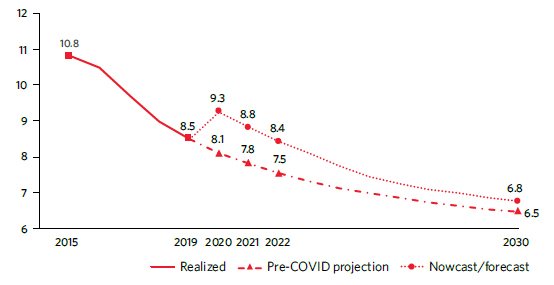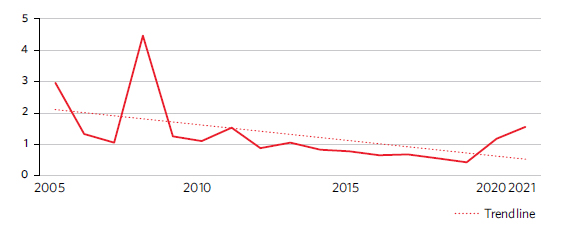No poverty

Daily life of residents living in the Sujat Nagar slum in Dhaka, Bangladesh.
© World Bank/Dominic Chavezopportunities, improve education and extend social protection to all, particularly the most excluded, is crucial to delivering on the central commitment to end poverty and leave no one behind.
Slow and uneven progress on poverty reduction may leave hundreds of millions in extreme poverty by 2030
Extreme poverty, currently defined as living on less than $2.15 per person per day at 2017 purchasing power parity, had experienced a significant decline in recent decades. However, COVID-19 reversed this positive trend. Even before the pandemic, the pace of poverty reduction was slowing, with extreme poverty falling from 10.8 per cent in 2015 to 8.4 per cent in 2019. The average annual reduction rate was 0.54 percentage points between 2015 and 2019, less than half the 1.28 percentage-point rate observed between 2000 and 2014. In 2020, the number of people living in extreme poverty rose to 724 million, surpassing the pre-pandemic projection by 90 million and reversing approximately three years of progress on poverty reduction.
Recovery from the pandemic has been slow and uneven, with extreme poverty dropping from 9.3 per cent in 2020 to 8.8 per cent in 2021. About 41 per cent of low-income countries experienced a higher poverty rate in 2021 compared to the previous year, versus only 13 per cent of uppermiddle-income countries. The conflict in Ukraine has disrupted global trade, leading to increased living costs that are disproportionately impacting the poor. Furthermore, climate change poses substantial threats to poverty reduction. By the end of 2022, nowcasting suggests that 8.4 per cent of the world’s population, or as many as 670 million people, could still be living in extreme poverty.
If current trends continue, an estimated 7 per cent of the global population – approximately 575 million people – will still be living in extreme poverty by 2030, with most in sub-Saharan Africa. This projection would represent a meager poverty reduction of less than 30 per cent since 2015.
Proportion of the world’s population living below $2.15/day, 2015–2019 realized and 2020–2030 forecast and projected (percentage)

If current trends continue, only one third of countries will halve national poverty by 2030
The national poverty line is a measure that is specific to a country’s economic conditions that can help policymakers design targeted interventions and social safety nets. In 2020, 22 out of 39 countries with data saw increases in national poverty rates relative to the previous year. Given the historical trends of 127 countries with data, only one third of countries will have halved their national poverty rates by 2030 from 2015.
Poverty is a complex and multidimensional challenge. Some countries have also adopted national multidimensional poverty indicators to capture other aspects of poverty – such as those related to health, employment, education and access to basic services – as well as to reveal the interconnections between deprivations across multiple Goals within households. Despite the implementation of these measures in a few countries, progress on reducing national multidimensional poverty has been limited. To address this, governments and stakeholders must target underlying factors and develop strategies to alleviate deprivations across multiple dimensions.
Amid overlapping crises, coverage and expenditures on social protection programmes remain low
The COVID-19 pandemic has highlighted the importance of social protection systems. However, in 2020, a mere 47 per cent of the global population was effectively covered by at least one social protection cash benefit, a slight increase from 45 per cent in 2015. Only 26.4 per cent of children under the age of 15 worldwide received social protection cash benefits, compared with 77.5 per cent of older persons. However, in low-income countries, only 23.2 per cent of older persons of pensionable age received social protection cash benefits. Similarly, globally, only 28.9 per cent of people considered vulnerable – all children, along with adults and older people not covered by contributory programmes – had access to non-contributory cash benefits.
Moreover, national expenditures on social protection for children and the elderly remain low, with upper-middle-income countries spending just 0.5 per cent and 1.4 per cent of GDP, and lower-middle-income countries spending 0.1 per cent and 0.8 per cent of GDP, respectively, in 2020. In response to the cost-of-living crisis, 105 countries and territories announced almost 350 social protection measures between February 2022 and February 2023. However, more than 80 per cent of these measures were short term in nature and around 47 per cent were general income support for the poor and vulnerable,
particularly children, families and the elderly population. To achieve the Goals, countries will need to implement nationally appropriate universal and sustainble social protection systems for all.
Proportion of children, vulnerable persons and older persons covered by social protection cash benefits, by income level of country, 2020 (percentage)

Advanced, emerging and developing economies alike have all increased their share of government spending on essential services
The share of government spending on essential services, including education, health and social protection, has increased over the past two decades. It accounted for approximately 53 per cent of total government expenditures globally in 2021, a rise from 47 per cent in 2015. This figure reached 62 per cent in advanced economies and 44 per cent in emerging and developing economies. The gap between them has remained relatively stable, at approximately 20 percentage points over the years. Looking into the different components of essential services, social protection spending in advanced economies was on average 17 percentage points higher than in emerging and developing economies, in part reflecting higher pension coverage in the former. The gap was lower when it comes to health spending, which was 6 percentage points higher on average in advanced economies compared to emerging and developing economies.
Globally, disasters are affecting more people but causing fewer deaths
At the mid-point of the 2030 Agenda for Sustainable Development and the Sendai Framework for Disaster Risk Reduction, there has been a progressive decline in disaster-related mortality. The global average annual number of deaths or missing persons per 100,000 population has steadily decreased worldwide, from 1.64 in the period of 2005–2015 to 0.86 in 2012–2021. In absolute terms, countries reported an average disaster mortality of 44,616 per year during this period. However, least developed countries (LDCs), small island developing States (SIDS) and landlocked developing countries (LLDCs) face higher vulnerability to disasters, with mortality rates of 1.24, 2.80 and 1.85, respectively, from 2012–2021. Despite the decline in global disaster-related mortality, the number of people affected by disasters per 100,000 population has increased from 1,198 during 2005–2015 to 2,113 in the 2012–2021 period (excluding cases related to COVID-19 ). Between 2015 and 2021, a staggering 151 million people on average were affected by disasters each year globally.
Disaster-related mortality rate (excluding COVID-19 deaths), 2005–2021 (deaths per 100,000 population)


